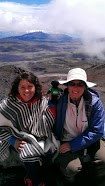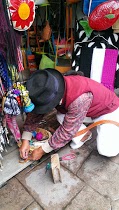Only one more adventure left in the Ecuador chronicles. The day before we returned home, we traveled to the Bellavista Cloud Forest Reserve. Those of you that know me, know I was traumatized by the selva from the Peru trip last year, so I was a bit apprehensive about the cloud forest. I learned last year that the idea of trekking through the Amazonian rainforest was much more appealing in theory than it was in practice – at least for me.
Don’t get me wrong, it was beautiful and fascinating, BUT…
It was super-hot all the time, and there wasn’t any power most of time. The power went on from 5:30 to 9:30 in the evening which got us a slow rotating fan in the room too high up to give a real breeze and 1 dim light bulb. No hot showers and it was probably a good thing I could not really see much in the bathroom. Glad I went, but I never want to go again. This girl enjoys nature, but at the end of the day I want a hot shower, cool beverage, and to sleep without the spiders…
Anyway, the point is that I was a bit apprehensive about going to the cloud forest. It was similar but yet different. Maybe because we only spent the day? Who knows, but that I would do again. In Spanish Bosque Nuboso is how you say cloud forest. It sounds pretty in both languages.
It was a 2 hour drive from Quito to Bellavista. We left early, around 6:30 am and had breakfast when we arrived at the reserve. It was a tasty breakfast of fruit with yogurt and homemade granola. This was followed by a plate of eggs as well. Karen procured a bag of granola for our hike. I do believe she bogarted it though! A hearty breakfast for those of us headed out to trek through the cloud forest was appreciated.
We met our guide, who briefed us about the hike. We would need our rain coats, a walking stick, and some wellies (rubber boots). We then had to decide which hike we wanted to go on – the easy one, the medium one, or the hard one. There was much debate, the hard one had the best scenery, but we were not sure if we were up to the challenge. I thought we settled on the medium difficulty trek and geared up. The cloud forest was phenomenal!
We started our journey, learning about the flora and fauna that characterized the area as we went. I soon discovered why we needed the wellies….A good portion of the trek required us to walk in a stream. Okay, I can dig it. No problem. That was until we reached the first waterfall. Oh yes, we are climbing it. No worries, our guide says. There is a ladder and a rope to help us. Ha! See for yourself. Still a bit scary for us city slickers. Oh, and there are 2 more along the way to our final destination. And no chickening out, this is a one-way trip, we are not going to return the way we came through.
I did it though, so did the rest of the gang. We were proud of ourselves. Although the first one was the most difficult in terms of height, the other 2 only had a rope, no ladder, to help us. Our final destination was a beautiful waterfall. Gracias, that we don’t have to climb that one too! When we were not either traversing the stream or climbing the waterfalls we were climbing up and down the terrain in mud.
It was very worth it in the end though. What an experience. The way back was less eventful, lots of mud and uneven terrain, not too scary though. When we arrived back, I joked that thank goodness that was only the medium trek. Our guide then says, oh no, that was the difficult one, it is the only way to get to the waterfall. I don’t think that any of realized before we left that we were going for the hard trek. I think we would have chickened out and said no. But in the end we were all glad that we did do it.
I learned that day not to underestimate my own abilities. And not to talk myself out of being able to do things that I had not tried before. If there were an option to not climb those waterfalls, I would have said I couldn’t do it. But I did, and I can. I great experience and a great life lesson that day.
























































































